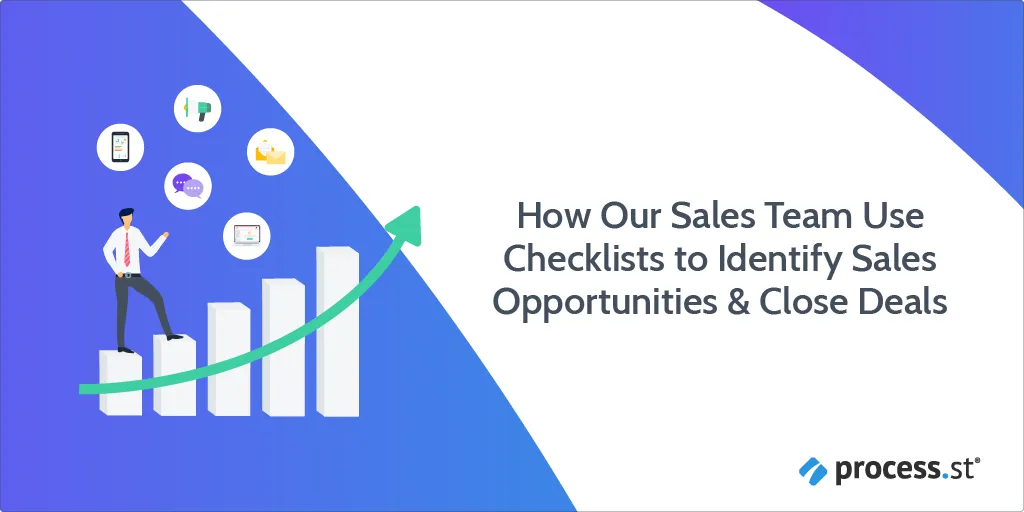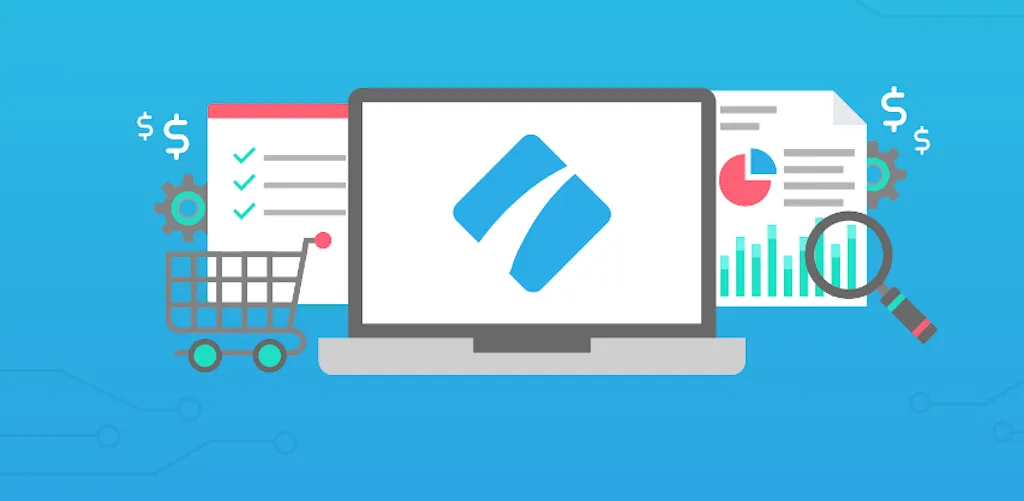How Our Sales Team Use Checklists to Identify Sales Opportunities & Close Deals
Blog: The Process Street Blog

“To succeed, jump as quickly at opportunities as you do at conclusions.” – Benjamin Franklin
Is your sales team prioritizing their time and channeling their efforts for the highest return? Are you sure you have the systems in place to take advantage of every sales opportunity that presents itself to you, from outreach to closing the deal?
Over the years, our sales team has built a few processes that help them maximize the impact of their daily recurring tasks. In turn, these processes are partially responsible for helping us along the way to over 450,000 registered users, including likes of Colliers, Salesforce, Accenture, Spotify, and Airbnb.
In this Process Street article I’ll share some of those sales processes with you.
We’ll cover how our sales team has used checklists to:
- Identify & lock-onto our highest value leads: According to the CMO Council, lost productivity and poorly managed leads cost companies at least $1 trillion every year. We don’t want to even lose $1 due to lost productivity. By using Process Street our sales team can manage leads efficiently.
- Quickly and easily respond to requests for trial extensions, discounts, upgrades, and more: From trial extensions, pricing, product explanation, and demos, a Process Street checklist can be created and run for all sale requests, standardizing processes and keeping teams abiding by best practice.
- Capture important information during the sales cycle: According to Accenture, 42.5% of sales reps take 10 months or longer before they contribute to the company goals. Capturing sales data helps Process Street’s sales team create actionable sales insights, insights both the sales leaders and reps can refer to and rely on to better reach their goals.
These processes are mainly used by our Account Executives every day – and I’ll cover how each of the checklists map to each stage of the sales cycle.
- A day in the life of a Process Street Account Executive
- Using Process Street in the sales process (from the perspective of our AEs)
- 4 sales checklists used by Process Street’s AEs
- 6 more top sales processes for you to capture and close high-value deals
A day in the life of a Process Street Account Executive
Our Account Executives (AEs) meet with clients daily to discuss ways Process Street can assist them in meeting their goals.
To succeed in their role, our AEs work with our highly trained, top-talented sales team, which includes:
- Leadership/VP of Sales
- Sales operations
- Sales Development Representatives (SDRs)
- Account Executives (AEs)
In this article, we’re specifically focusing on the day-to-day work done by our Account Executives (AEs).
However, this work relies on the communication and collaboration between our AEs and other members of our sales team.
For instance, without our SDRs, our AEs would sit around jobless. It’s the SDRs who reach out to bring in new signups, sending out email campaigns, and finding people who might be interested in talking to our AEs.
In essence, our SDRs book the client calls for our AEs. The AEs then use these calls to close deals, manage trials and the sales cycle.
A standard day for our AEs would look something like this:
- SDRs would follow up, reach out, and confirm meetings (email or call) to then schedule a meeting’s time and date on the AEs calendar.
- AEs are prompted to give demo requests when a prospect visits Process Street’s website and clicks the demo request button. Clicking this button presents the prospect with the AEs Calendly link, which is used to book a demo/call directly with the AE.
- AEs use demand generation and outbound social campaigns to generate opportunities with people who don’t know about Process Street. Again, meetings can be booked with AEs using Calendly.
Our AEs spend most of their time on calls and talking to new signups. During these calls, they will run our Discovery Checklist ( we’ll unpack this below ) to show the product.
For bigger deals, AEs may run an example process and edit/build part of that process for a more detailed demo.
We’ll explore the 4 main checklists our AEs use to streamline their daily sales tasks. But before all that, let’s think about how these checklists fit into the sales process from an Account Executive’s perspective.
Using Process Street in the sales process (from the perspective of our AEs)
We have broken the sales cycle down into its constituent stages. This is how our AEs and our sales team think about this cycle, using specific Process Street checklists at each stage.
Process Street is used to improve the way information is captured at key points. For most of the daily recurring processes, our AEs are working inside of Salesforce. In Salesforce, Process Street’s checklist run links are embedded, which act to integrate the 2 applications.
In effect, all our AEs have to do is click on these links to automatically generate and run the given checklist.
Since our AEs live in Salesforce, this makes running Process Street checklists super easy and straightforward.
Let’s see how these checklists aid the sales cycle for our AEs.
Stage 1: Sales discovery
It’s during the sales discovery step that the needs and problems of a given prospect are determined, giving explanations of how the product – Process Street – solves the prospect’s pain points.
The sales discovery step is the first step our AEs take towards connecting with our prospects. During this phase, prospect research is conducted, and AEs will connect with them by phone, email, etc.
The aim during the sales discovery stage is to ask key qualifying questions and to answer questions your prospects have. You’ll want to be taking a proactive approach, providing a solution via your product or service to hopefully move the prospect along the sales pipeline.
At Process Street, we like to run demos (maybe multiple demos) during this stage, to show the customer how our service can solve their unique pain points.
Key processes for this stage of the sales process:
- Running an effective discovery call.
- Running a product demo.
- Potentially extending the client’s trial to facilitate evaluation & negotiations.
Stage 2: Early evaluation/consideration
In the early evaluation stage, the prospect is deciding whether or not the product is a good fit. At this stage, it’s too ambiguous to say that the prospect is interested in your product or service offering.
To aid your prospect in making a decision, consider running product demos – depending on the size of the organization and the red tape involved. It must be noted that there’s an average of 6.8 customer stakeholders involved in a typical purchase, so you’ll want to practice multi-threading, or connecting with multiple decision-makers on the purchasing side.
Key processes for this stage of the sales process:
- Running a product demo.
- Progressing with product call requests.
- Taking customer calls and attending meetings.
- Sales pitch planning.
- Sales presentation process.
Stage 3: Active evaluation
The active evaluation stage is a more thorough evaluation of the product or service offering completed by the customer. It’s at this stage where the customer is actively testing the product or service. This time investment should be seen as a good sign, as the customer is deciding whether the product or service is a good fit before they become more committed.
Active evaluation begins when the client starts putting energy into making the purchasing decision themselves. They’re not relying on passive demos presented by the AEs, your clients are thinking about your offering in their own time.
There’s not much our AEs can do during this stage, as the outcome relies on active product or service evaluation on the prospect’s side. AEs need to ensure they are readily available to answer any queries/resolve confusions that might arise, or revisit the sales proposal.
Key processes for this stage of the sales process:
- Sale proposal revisits might be required.
- Sending sales proposals to the customers.
- Running team-wide communication processes, for sale relevant updates.
Stage 4: Negotiation
The sales negotiation stage is a strategic discussion between the buyer and the seller that ideally leads to the deal being closed. The main purpose of the negotiation phase is to reach a deal agreement that’s acceptable to everyone.
In our sales negotiations, our prospects will communicate what they need and where they may be able or willing to make concessions. Our AEs will look into how they can compromise, for instance, looking into price or contract terms and conditions.
Key processes for this stage of the sales process:
- Finalizing the sales process.
- Making relevant changes to the customer’s plan.
Stage 5: Closing the deal
Closing the deal is a make-or-break moment in sales. It’s the stage that determines the final verdict of whether or not your efforts will amount to anything at all.
Our AEs have to make sure they are using the right techniques and language to seal a sales deal. Running Process Street processes ensures standard procedures are applied on a team-wide level.
However, in the past, it sometimes proved difficult to ensure the process was always being followed. To solve these issues, Process Street’s sales team set up a Process Steet + Slack integration.
With this integration, any notes made in a given Process Street checklist can be automatically pushed into Slack. This provides visibility and transparency for both the Sales leadership team and the product team.
This integration aids team-wide communication and celebration of deal closure. For instance, images/GIFs are pushed into the appropriate Slack channel when a deal is closed.
Once more, combining the 2 applications – Process Street and Slack – just got easier with Process Street’s Slack app.
Key processes for this stage of the sales process:
- Running a deal closure process, which is standardized for consistency.
- Team-wide communication and celebration of deal closure.
4 sales checklists used by Process Street’s AEs
Let’s take a closer look at the checklists our AEs use for facilitating sales opportunities.
Our sales team has built the checklists they use from scratch in Process Street.
They have done this by documenting each step of the sales process and transcribing these steps into a Process Street checklist.
Because they’re so specific to our sales team, they’re not public – but we do have some additional checklists later on in this post that you can use for your own recurring sales tasks.
I have included screenshots when introducing each checklist to aid understanding.
You can also create your own sale checklists quickly and easily with Process Street. Here’s a quick video:
Using checklists means we can focus on building really good process templates and then distribute them across the team, making it easier than ever to enforce best practices.
Automatically processing Stripe requests using our Stripe Request checklist
A common use case for our AEs is called a Stripe request.
A checklist run-link for the Stripe Request checklist sits in Process Street’s Salesforce account. Clicking this link opens up the checklist in Process Street. This means the sales team can quickly and effortlessly process requests like trial extensions, upgrades, plan discounts, coupons, etc, via Stripe.
Reps from the Customer Success team are also automatically notified via Slack when the necessary steps are completed.
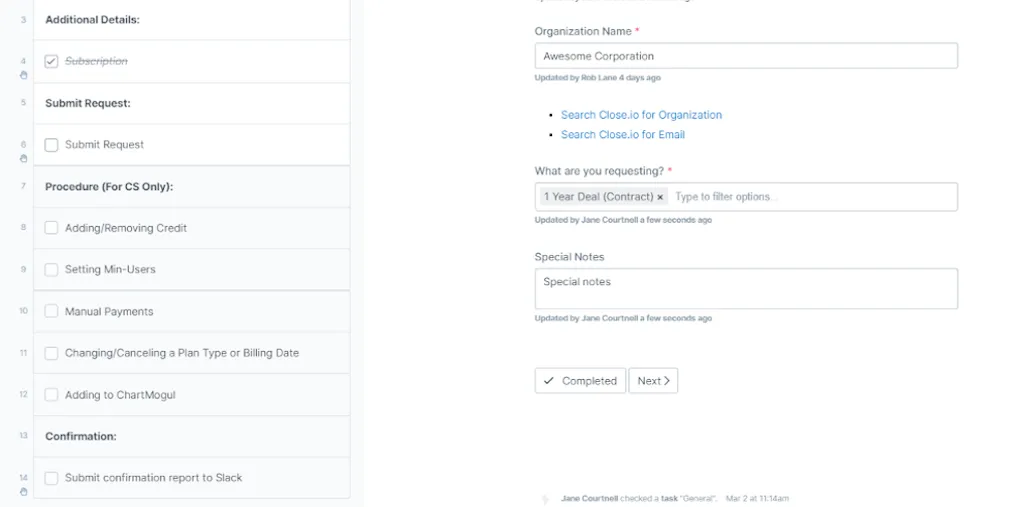
Our Stripe Request checklist relies heavily on our Conditional Logic feature. This feature adapts the checklist so that it caters to each unique use case.
For instance, in the above image, the Stripe request download plan is selected, which alters the subsequent tasks to be presented – which you can view in the left-hand sidebar.
If another use case was selected, such as 1 Year Contract (Deal), different subsequent tasks will follow, which once again can be viewed via the left-hand sidebar (as shown in the image below).
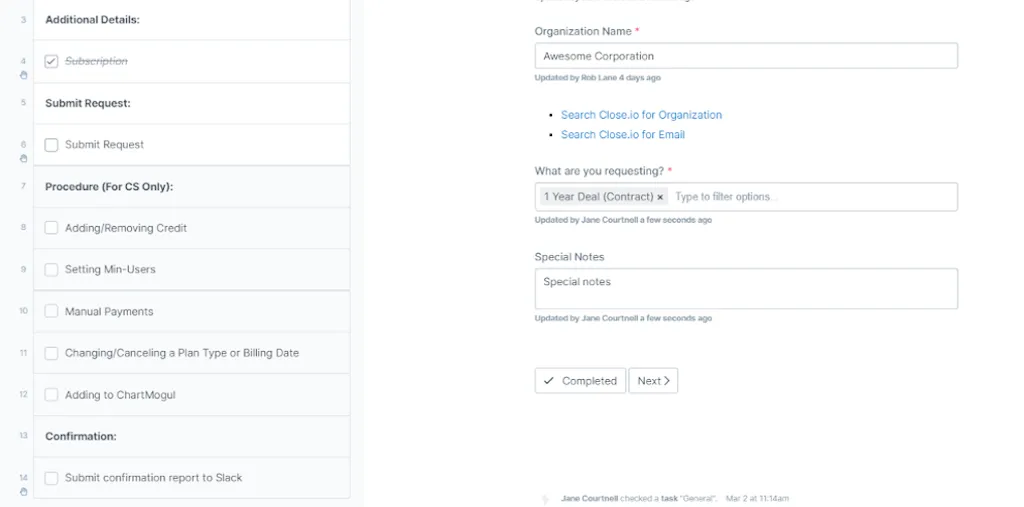
Ultimately, our Conditional Logic feature means different stripe requests can be handled in a standardized manner all from a single checklist.
Main checklist benefits
The benefits of running our Stripe Checklist are as follows:
- Our sales team, who don’t have ownership of Stripe (that’s CS), can easily understand how to, and conveniently request changes.
- Clicking the checklist run link from Process Street’s Salesforce account populates info automatically into the Stripe checklist saving time. This makes it easy for the sales team to make changes to the billing or the trial period for clients/prospects.
- Without our Stripe checklist, the process for requesting the required sale proposal changes would be more complicated.
- The Customer Success team has an easy-to-follow guide for what they need to do on the back end.
- Our sales team leaders can rest in confidence that tasks are being executed as required.
Checklist use case
Our Stripe Request checklist is to be run either at the start of the sales process or at the end of the process. More specifically, use cases include:
- When clients are running close to the end of their trial period but they need more time to decide whether they want to continue to use their Process Street account.
- Informal trial extension negotiations.
- Formal process changes based on signed proposals.
Discovery Call checklist
Our Discovery Call checklist presents the opportunity for our AEs to get to know the customer to see if they’re a good business fit. Our Discovery Call checklist is the first conversation the AEs have with a prospect after they show an initial interest in Process Street.
Again the run link to our Discovery Call Checklist is available in the Account Executive’s Salesforce account.
You don’t want to bog your prospect down with lots of information, or take too much of their time during the discovery call – it’s best to keep it short and sweet. This recommendation is reflected in our Discovery Call checklist, as you can see from the image below, the process is short.
This is the beauty of Process Street, you can document any business operation via a Process Street checklist regardless of process length.

A very useful feature in our Discovery Call checklist is our Embed Email Widget. With this feature, information entered in form fields from the previous steps automatically populate an email, which can be sent to the relevant contact from within the Process Street checklist.
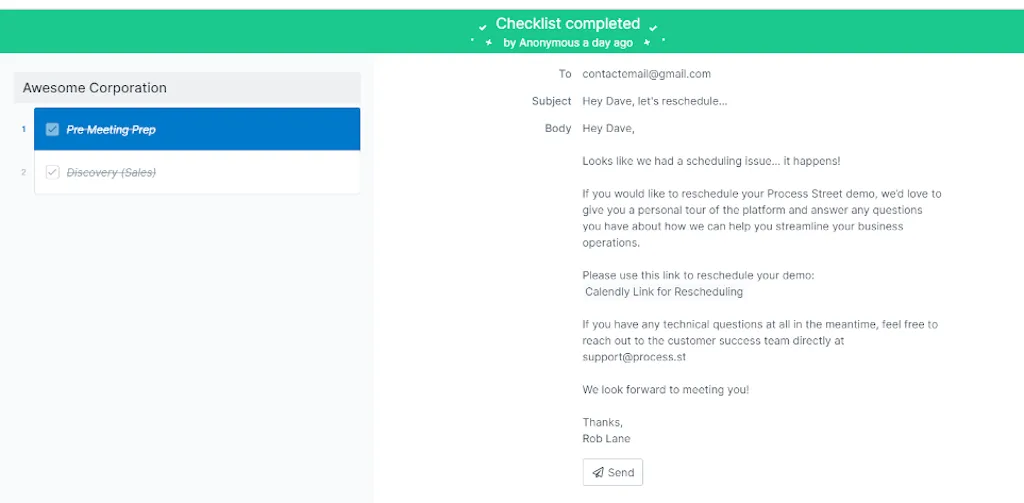
Main checklist benefits
- Our Discovery Call Checklist has been designed to be run by anyone, regardless of experience level. The checklist contains battle cards, which are essentially quick refreshers for users that haven’t used the checklist in a while.
- The checklist presents questions around each use case, plus the challenges, successes, KPIs, and financial impacts of each. This is vital information for any sales team, to track their progress and understand the impact of each prospective deal, and it’s all presented in one place, at the right time.
- Sales metrics are presented ahead of time keeping the sales team vigilant of potentially worrisome churn rates, or if they’re looking to improve outreach attention.
- Our Discovery Call Checklist uses a gap selling methodology. That is, what are the problems? What’s the solution? The checklist then draws the user to think about the future state, that is, what does success look like?
- All data collected in this checklist is used to automatically populate the given Slack channel.
Checklist use case
Our Discovery Call Checklist is to be run at the start of the sales cycle to learn about the client’s needs and how the product will help the client meet those needs.
Sales Proposal checklist
Our Sales Proposal Checklist is run to produce a sales proposal document, used by Process Street‘s AEs to pitch our service to potential clients and customers. The sales proposal produced shows how Process Street, as a business process management tool, can service the BPM market, and meet the business needs of our customers.
Checklist form fields are used to collate sale proposal information, meaning this information can be stored in the cloud and accessed by the relevant person from anywhere, at any time, subject to permission settings.

Obtaining the relevant approval in good time is vital for running a streamlined, error-free operation. Documenting the sales proposal is the penultimate step before closing the deal, so you don’t want anything to go awry. In our Sales Proposal checklist, we use Process Street’s Approvals feature to notify upper management that a review of the sale proposal details is needed. Once this review is completed, management can give the go-ahead or rejection (with comments) as necessary.
Our Approvals feature is used in combination with our Task Assignments feature, meaning senior personnel receive the Approval task in their Process Street inbox. From here, they can complete the Approval task without having to open the checklist. Yes, it’s that simple.
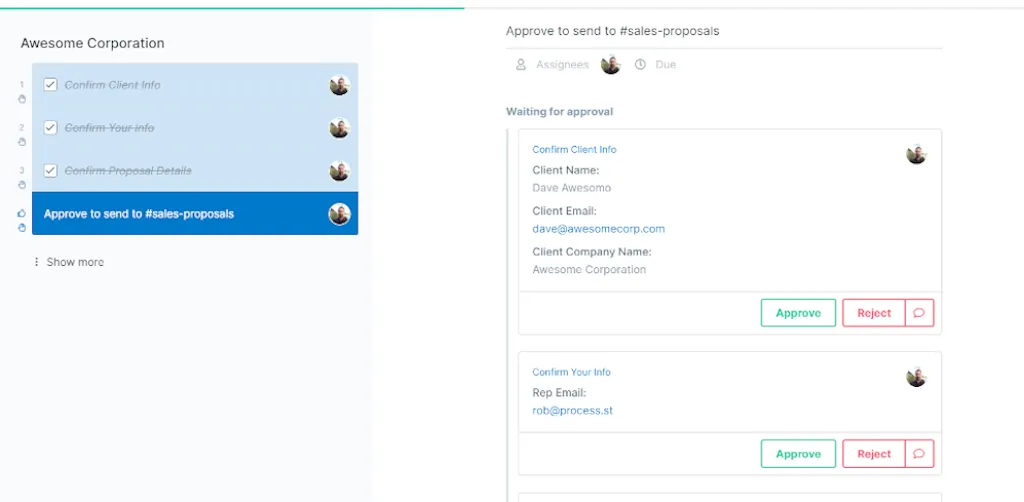
Main checklist benefits
- The Sales Proposal Checklist provides a safe and secure space to collect information needed to generate a sales proposal. Information such as user count, the price per user, and additional terms are obtained.
- Using our Approvals feature, the checklist streamlines the approval process from the managerial’s side, preventing lengthy delays.
- Messages are automatically sent into the instant messenger application Slack, keeping inter and intradepartmental teams in the loop regarding sales processes.
- Sale proposals are automatically sent to the customer via Hellosign. When the customer signs, a message is sent as a confirmation to Process Street’s Slack channel and Chatter in Salesforce, with a note. This establishes quick and effective communication channels between team members.
Checklist use case
Our Sales Proposal Checklist is designed to be run later in the sales cycle, to propose a discount.
Deal won checklist
Our Deal Won Checklist summarizes, records, and stores basic details such as the SDR’s email, customer contact, whether there’s a signed proposal or not, a record of the given proposal, the client use case, deal value and the number of deal users.

Using our file upload form field, the accepted proposal can be uploaded and stored within the checklist. This keeps all information secure and easily accessible.
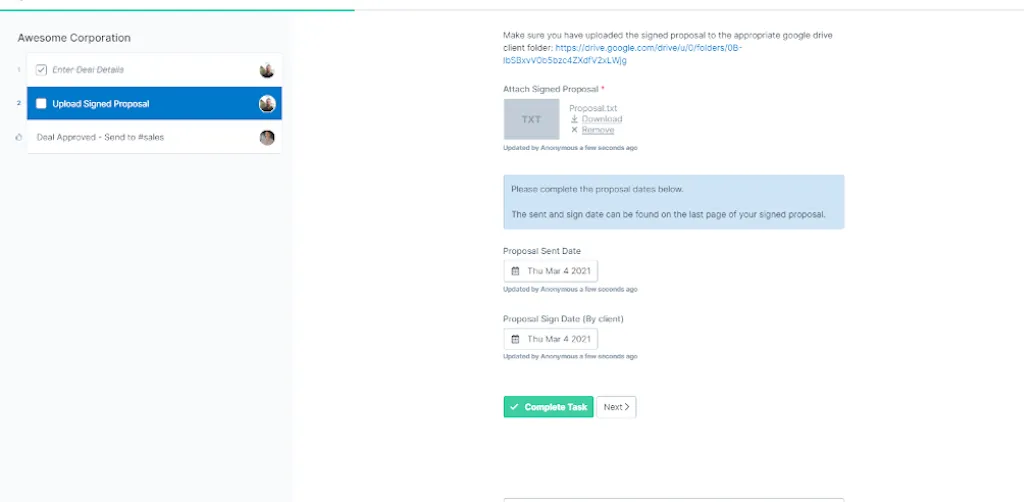
Main checklist benefits
- By storing the sales deal information in a Process Street checklist, you have data that can be accessed at any time from anywhere, using Process Street’s Task Permissions feature to control which personnel have access.
- Our Deal Won checklist also collates information/stats that’ll provide an estimation for the sales cycle length, such as the demo date, the date that the money hit, first contact, and the date that the lead signed up.
- An Approval step is automatically sent to the VP of sales. This streamlines the approval process preventing lengthy delays.
- Once the deal is complete, automatic image/GIF messages are sent via Slack to the sales teams in celebration. This is good for remote teams in keeping team relationships and spirits high. These messages are thought of as Bang the Gong moments, with kudos attributed to the SDR team member who closed the deal.
Checklist use case
Our Deal Won Checklist is to be used once a deal has been signed off.
6 more top sales processes for you to capture and close high-value deals
A sales process is a set of repeatable steps a salesperson will follow to take a prospective buyer from the early awareness stage to closing the sale.
Running effective sales processes, as we do at Process Street, will drive:
- Efficiency improvements
- Build a better organization
- Increase revenue and forecasting accuracy
- Drive continuous improvements
Below I have listed 5 of our top sales processes, which you can access for free from your Process Street account.
You will find an extensive list of our top sales processes in our template library, I recommend you check them out.
The following sales processes will give you a taster of the type of checklist we offer at Process Street.
Inbound Sales Lead Discovery Checklist
Our sales team use this checklist to determine which leads they should spend their energy on. It helps them sift through the noise and lock-onto the highest value leads.
We use it in combination with a Salesforce integration that automatically runs this checklist whenever someone signs up to our product.
Sales Onboarding Checklist
To run any effective sales process, you need a good team behind you.
Run our Sales Onboarding Checklist to hire new sales staff, train them with the required skills and knowledge, instill company values, and show them how to leverage the provided tools of a company.
Click here to accesso our Sales Onboarding Checklist!
Contact Prospects via Phone and Email
During the discovery phase, you’ll want to be contacting your prospects using phone/email.
Run our Contact Prospects via Phone and Email checklist when contacting a prospect via phone, email, or both.
Click here to access our Contact Prospects via Phone and Email checklist!
BANT Sales Qualification Call Process
During the evaluation phases of the sales process, you’ll want to help your prospects determine whether your service is a good fit for their goals. This requires determining the prospect’s use case, budget, need, and timeframe.
Use our BANT Sales Qualification Call Process to qualify your sales leads.
Click here to access our BANT Sales Qualifications Call Process!
Upselling Sequence Email Process
During the negotiation phase of the sales process, you might want to consider changing the sales proposal. Are there other features that would prove useful to your prospect to upsell your product?
Run our Upselling Sequence Email Process as an aid for you to develop a series of emails designed to upsell your product.
Click here to access our Upselling Sequence Email Process!
Closing The Sale Checklist
Once your sales deal is won, after the negotiation phase, use our Closing The Sales Checklist. In this checklist, we provide advice on closing techniques and then guide you through the process of checking all documentation and relaying the necessary information to the relevant teams.
Click here to access our Closing The Sales Checklist!
Start running effective sales processes. Capture sales opportunities. Close deals. Strive for success.
What sale processes do you run to capture sales opportunities and close high-value deals? What challenges and successes have you faced? We’d love to hear from you, please comment below. Who knows, you may even get featured in an upcoming article!
The post Blog first appeared on Process Street | Checklist, Workflow and SOP Software.
